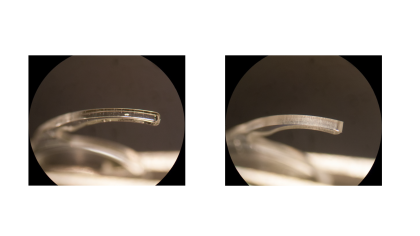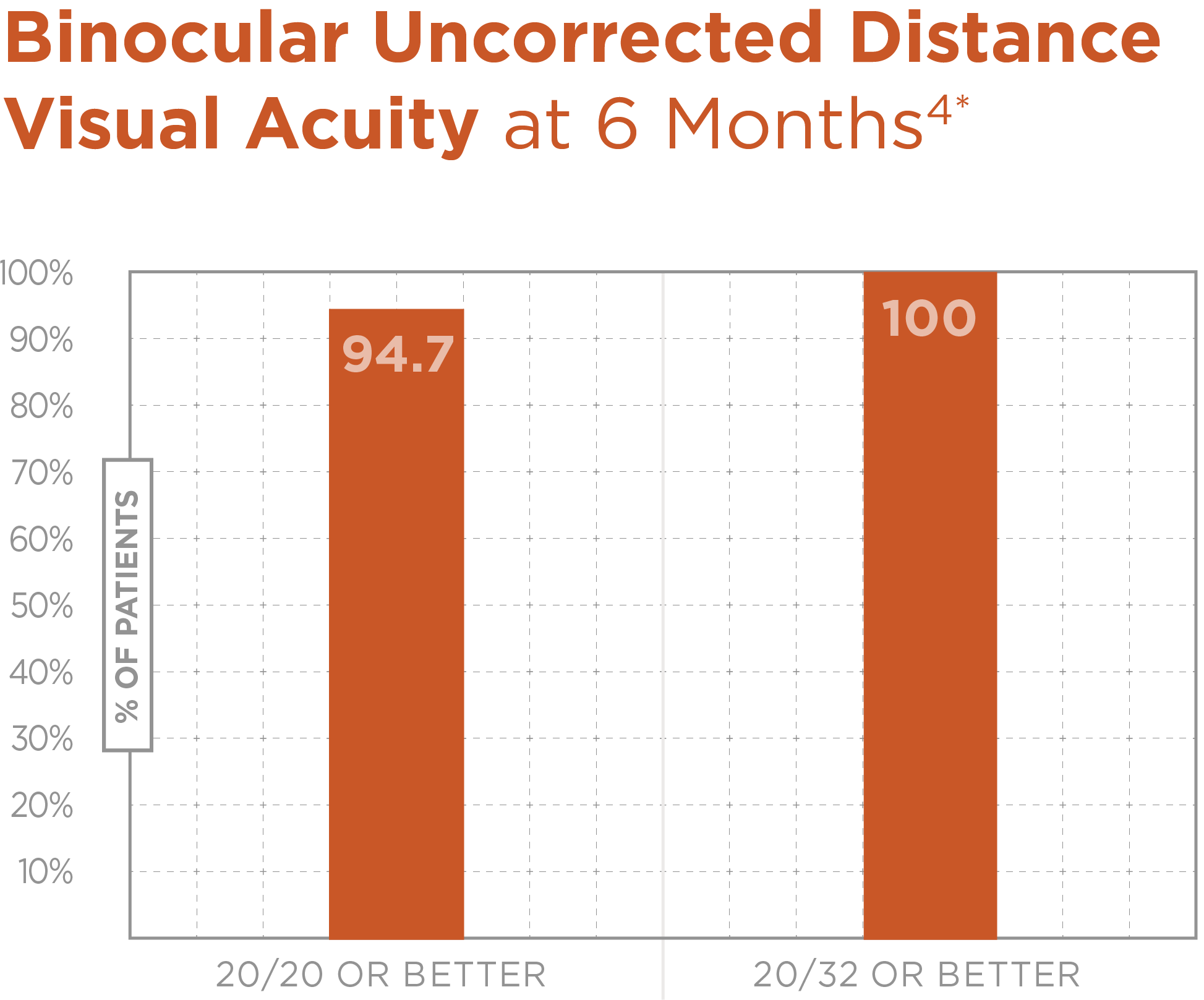TECNISTM Toric II 1-Piece IOL
TECNISTM Toric II 1-Piece IOL
To order this product, please contact your sales rep.
May not be available for all countries.
Instructional Guides
Instructional Guides
Instructional Guides
Get a Grip on Visual Performance
With its squared and frosted haptic design the TECNIS™ Toric II platform delivers exceptional rotational stability.1
TECNIS™ Toric 1-Piece IOL (non-frosted) TECNIS™ Toric II 1-Piece IOL (frosted)

- 100% of surgeries had less than 5° rotation at 3-months1
- Mean rotation of TECNIS™ Toric II IOL was 0.94° at 3-months postoperatively1
- As much as 31% improved image contrast over AcrySof® IQ IOLs2
- Proven low-light performance2
- High-quality distance vision1
Optimize your outcomes with the TECNIS Toric Calculator.
Leverage toric IOLs to reduce residual refractive cylinder and increase spectacle independence for distance.3,4
- 94% of eyes achieve ≤ 0.50 diopters of residual refractive cylinder3
- 94.7% of patients achieved binocular uncorrected distance visual acuity of 20/20 or better4

Unlike another leading IOL, TECNIS™ IOL material is not associated with glistenings,5-9 which can inhibit your patients’ vision. Glistenings cause light scatter, which can result in a reduction in image contrast.6-10
Unlike another leading IOL, TECNIS™ IOL material is not associated with
glistenings,5-9 which can inhibit your patients’ vision. Glistenings cause light scatter, which can result in a reduction in image contrast.6-10
97% of patients would elect to have the TECNIS™ Toric IOL again.3
|
OPTIC CHARACTERISTICS11 |
||||||||||
|
Powers: |
+5.0 D to +34.0 D in 0.5 diopter increments. |
|||||||||
| Model Numbers: |
ZCU100
|
ZCU150 | ZCU225 | ZCU300 | ZCU375 | ZCU450 | ZCU525 | ZCU600 | ZCU700 | ZCU800 |
| Cylinder Powers – IOL Plane: | 1.00 D | 1.50 D | 2.25 D | 3.00 D | 3.75 D | 4.50 D | 5.25 D | 6.00 D | 7.00 D | 8.00 D |
| Cylinder Powers – Corneal Plane: | 0.69 D | 1.03 D | 1.54 D | 2.06 D | 2.57 D | 3.08 D | 3.60 D | 4.11 D | 4.80 D | 5.48 D |
|
Diameter: |
6.0 mm |
|||||||||
|
Shape: |
Biconvex, anterior toric aspheric surface, square optic edge |
|||||||||
|
Material: |
UV-absorbing hydrophobic acrylic |
|||||||||
|
Refractive Index: |
1.47 at 35° C |
|||||||||
|
Edge Design: |
ProTEC frosted, continuous 360° posterior square edge |
|||||||||
|
BIOMETRY |
CONTACT ULTRASOUND§ |
OPTICAL*,‡ |
||||||||
|
A-Constant: |
118.8 |
119.3 |
||||||||
|
Theoretical AC Depth: |
5.4 mm |
5.7 mm |
||||||||
|
Surgeon Factor:12 |
1.68 mm |
1.96 mm |
||||||||
|
HAPTIC CHARACTERISTICS11 |
||||||||||
|
Overall Length: |
13.0 mm |
|||||||||
|
Configuration: |
Tri-Fix design, modified C, integral with optic |
|||||||||
|
Material: |
UV-absorbing hydrophobic acrylic |
|||||||||
|
Design: |
Haptics offset from optic, haptics have a squared and frosted design |
|||||||||
IOL INSERTION
Recommended insertion instruments:
- The UNFOLDERTM Platinum 1 Series Implantation System: Intuitive push-and-twist, screw-style insertion designed to simplify lens implantation.
FOOTNOTES
* Based on average pseudophakic human eye and ‘Holladay et al. A three-part system for refining intraocular lens power calculations. J Cataract Refract Surg. 1988;14(1):17-24. REF2014CT0092.
‡ Derived from clinical evaluation results of the TECNIS™ 1-Piece IOL Platform for optical biometry.
§ A-Constant theoretically derived for ultrasound biometry.
REFERENCES
1. DOF2021CT4019 – Clinical Investigation of Rotational Stability of the TECNIS™ Toric II IOL – From Study NXGT-202-QROS. 20 Aug. 2021.
2. DOF2015OTH0006 – TECNIS™ and competitor toric IOL MTF data. 4 May 2015.
3. Black D. Efficacy of hydrophobic acrylic toric IOL to correct astigmatism in cataract patients. Presented at ASCRS 2015. REF2015CT0193.
4. Post-Approval Study of the TECNIS™ Toric IOL Extended Cylinder Range (ECR), Models ZCT450, ZCT525 and ZCT600. 30 August 2017. REF2018CT4111.
5. 150 – Data on File – SENSAR™ not associated with glistening – Literature analysis. May 2013. REF2014OTH0002.
6. Nagata M, et al. Clinical evaluation of the transparency of hydrophobic acrylic intraocular lens optics. J Cataract Refract Surg. 2010;36(12):2056-2060. REF2015CT0080.
7. Christiansen G, et al. Glistenings in the AcrySof® intraocular lens: Pilot study. J Cataract Refract Surg. 2001;27(5):728-733. REF2014MLT0005.
8. Colin J, et al. Incidence of glistenings with the latest generation of yellow-tinted hydrophobic acrylic intraocular lenses. J Cataract Refract Surg. 2012;38(7):1140-1146. REF2014MLT0006.
9. Gunenc U, et al. Effects on visual function of glistenings and folding marks in AcrySof® intraocular lenses. J Cataract Refract Surg. 2001;27(10):1611-1614. REF2014MLT0011.
10. Van der Mooren M, Franssen L, Piers P. Effects of glistenings in intraocular lenses. Biomed Opt Express. 2013;4(8):1294-1304. REF2014OTH0139.
11. TECNIS™ Toric II IOL, Model ZCU100-ZCU800 – DfU OUS – Z311613, current revision.
12. Holladay JT. International Intraocular Lens & Implants registry 2003. J Cataract Refract Surg. 2003;29:176-197. REF2016CT0151.
2024PP15294

